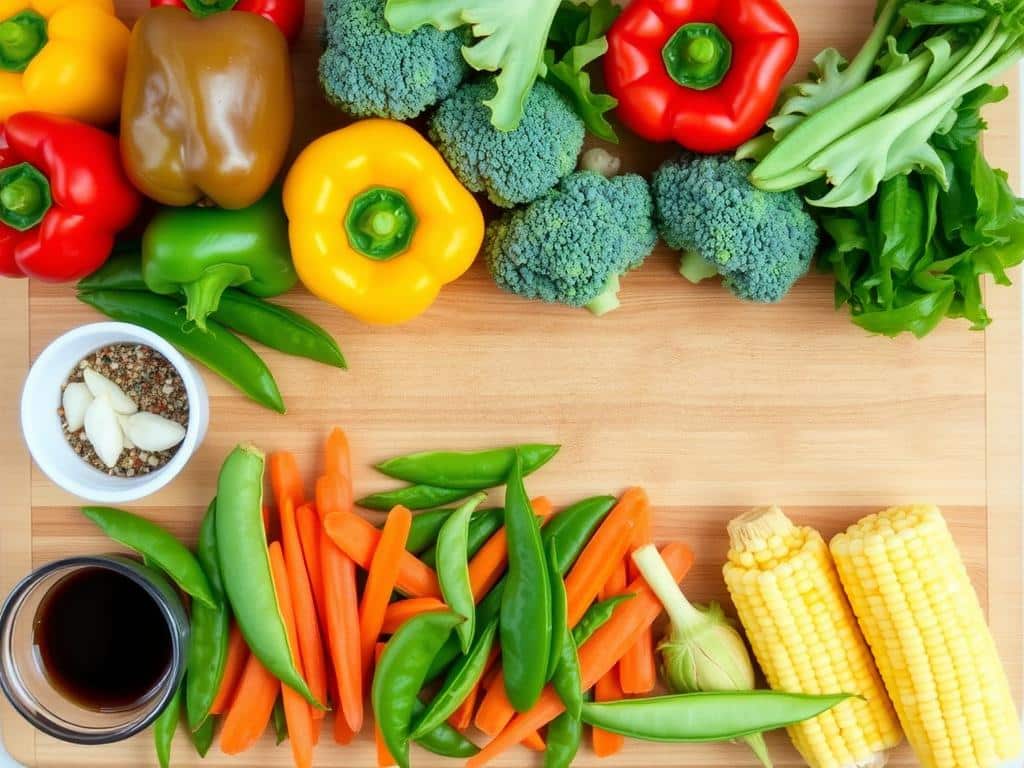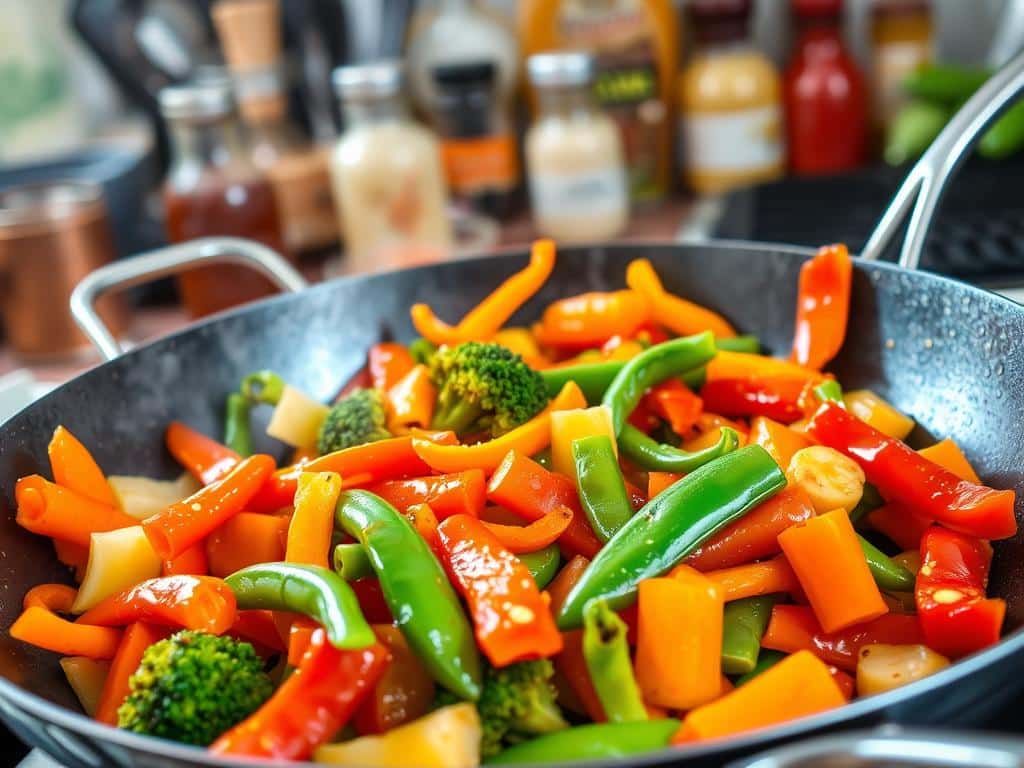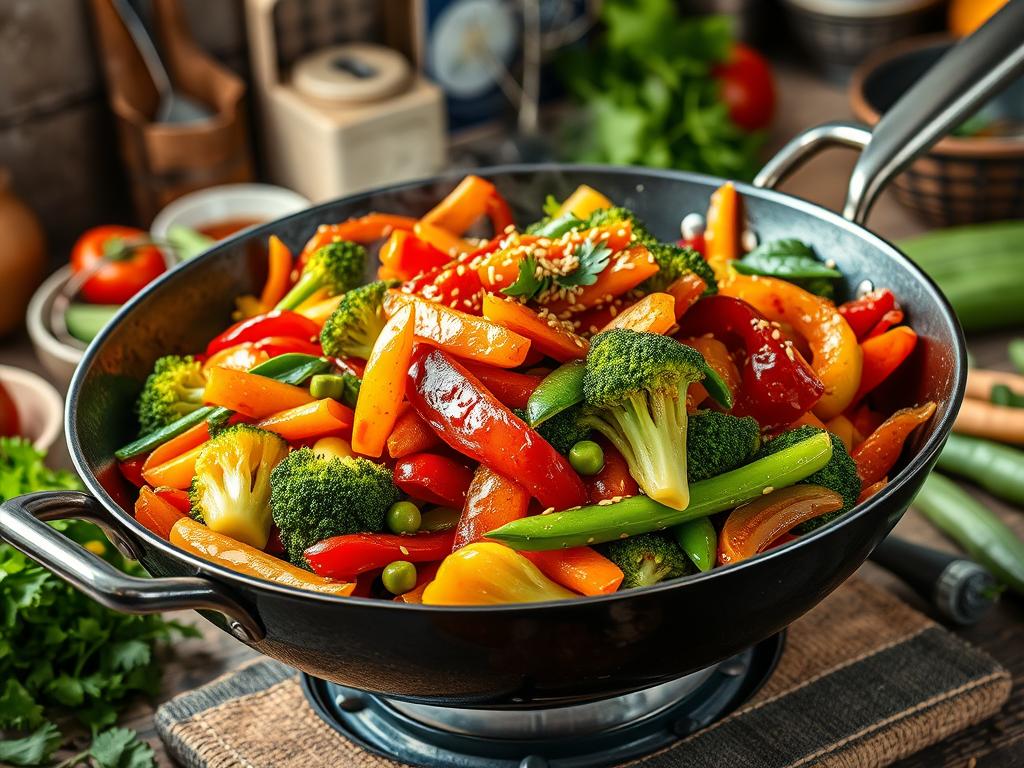We’re excited to share our quick veggie stir fry recipe with you. It’s a fast and flavorful dish perfect for busy adults. You’ll learn how to make a tasty stir fry with simple ingredients. It’s an easy vegetarian recipe to add to your collection.
Our goal is to make cooking easy and enjoyable for you. This way, you can have a healthy stir fry on the table in no time.
As we guide you through this recipe, you’ll see how easy it is to prepare a healthy stir fry. It’s not only delicious but also packed with nutrients. So, what makes a quick veggie stir fry the perfect solution for a fast and flavorful meal? Let’s dive in and find out.
Key Takeaways
- Learn how to make a quick veggie stir fry using simple ingredients
- Discover the secrets to creating a flavorful and healthy stir fry
- Get tips on how to make cooking easier and more enjoyable
- Find out how to customize your stir fry to suit your taste preferences
- Learn about the benefits of a healthy stir fry for a balanced diet
- Get inspired to try new easy vegetarian recipes
Ingredients for a Delicious Veggie Stir Fry
To make a tasty veggie stir fry, you need the right ingredients. We’ll show you how to pick the best ones for your dish. Whether you’re new to cooking or experienced, our advice will help you make a healthy and delicious meal.
A great veggie stir fry starts with fresh veggies like broccoli, bell peppers, and carrots. Pick your favorites or mix them for a colorful dish. You can also add tofu or tempeh for extra protein.
Fresh Vegetables to Include
- Broccoli: rich in vitamins and antioxidants
- Bell peppers: add a sweet and crunchy texture
- Carrots: high in fiber and vitamins
You’ll also need pantry staples like soy sauce, olive oil, and garlic. These add flavor and aroma to your stir fry. Try different seasonings and sauces to find your favorite.
Essential Pantry Staples
- Soy sauce: adds a savory and umami flavor
- Olive oil: a healthy and versatile cooking oil
- Garlic: adds a pungent and aromatic flavor
With these ingredients, you can make a quick and delicious veggie stir fry. It’s perfect for a fast meal for yourself or your family. Our tips and recipes will guide you to a healthy and tasty dish.
Choosing the Right Oil
Choosing the right oil is key for a tasty and healthy stir fry. We’ll guide you through picking the best oil for your vegetable stir fry. With many options, it can be hard to decide.
A good stir fry oil should handle high heat well. This is crucial since stir-frying cooks ingredients quickly at high heat. Olive oil, coconut oil, and avocado oil are popular choices.
Common Oil Options
- Olive oil: great for low-heat stir-fries and adding a rich, fruity flavor
- Coconut oil: ideal for high-heat stir-fries and adding a unique, nutty flavor
- Avocado oil: perfect for medium-heat stir-fries and adding a mild, buttery flavor
Health Benefits of Different Oils
Each oil has its own health perks. Olive oil is full of antioxidants and can lower inflammation. Coconut oil has MCTs that aid in weight loss and digestion.
When to Use Each Type
So, when to pick each oil? Use olive oil for delicate veggies. For heartier ingredients like meat or tofu, coconut or avocado oil is better. Try different oils to find your favorite for vegetable stir fries.
Essential Seasonings and Sauces
Seasonings and sauces are key to a tasty and healthy stir fry. We’re talking about a simple vegetarian recipe that’s full of flavor. The right seasonings balance salty, sweet, and umami flavors.
Start with soy sauce. It’s a must in many Asian dishes and adds a rich flavor. Try tamari or coconut aminos for different tastes.
Soy Sauce and Its Variations
Soy sauce is essential in any stir fry, especially in vegetarian recipes. It brings depth and umami, balancing the dish. Remember to taste and adjust the seasoning as you go.
Adding Heat with Chili Sauce
Chili sauce is great for those who like spice. It adds a fiery kick and enhances other flavors. Use it sparingly, as it’s strong, and adjust to taste.
Enhancing Flavor with Garlic and Ginger
Garlic and ginger are staples in stir fries. They add a strong flavor and aroma. Mix them with soy sauce and chili sauce for a flavorful stir fry.

Adding these seasonings and sauces to your vegetarian recipe makes a delicious and healthy stir fry. It’s sure to please everyone. So, get creative and find the perfect mix for you.
Preparing Your Vegetables
Preparing your vegetables is key to a tasty quick veggie stir fry. We aim to help you use your ingredients wisely and cut down on waste. Start by cutting your veggies the same size. This ensures they cook evenly and fast, ideal for a quick stir fry.
Here are some tips for cutting your vegetables like a pro:
- Use a sharp knife to prevent tearing or crushing the vegetables
- Cut vegetables into similar-sized pieces so they cook at the same rate
- Consider prepping your vegetables in advance to save time during cooking
By following these tips, you’ll be on your way to making a delicious and efficient stir fry. Remember to store leftover veggies right to keep them fresh for your next meal. With practice, you’ll become a stir-fry expert, making dishes that impress everyone!
As you try out different stir-fry recipes, don’t forget to experiment with seasonings and sauces. This will add extra flavor to your meals. For more ideas, check out our collection of quick and easy dinner recipes. They offer a variety of meal ideas that can be made in no time.
Cooking Techniques for Stir Frying
Cooking techniques are key to a tasty simple veggie stir fry. We aim to guide you to the perfect texture and flavor. High heat is crucial for quick cooking and to keep veggies crisp.
A simple veggie stir fry can use many ingredients. Serving it with veggie stir fry noodles is a tasty and easy option. Now, let’s explore the cooking techniques for stir-frying.
The Importance of High Heat
High heat is vital for stir-frying. It cooks veggies fast and keeps their color and texture. Always stir constantly to avoid burning.
Using a Wok vs. a Skillet
A wok is traditional for stir-frying, but a skillet works too. Choose a pan that heats evenly and is big enough for all ingredients. For a simple veggie stir fry, a skillet is often easier to use.
Stirring and Tossing Techniques
Stirring and tossing are essential in stir-frying. They ensure even heat and prevent sticking. Mastering these techniques will help you make a delicious simple veggie stir fry with noodles.
Here are some stir-frying tips:
- Use high heat to quickly cook the ingredients.
- Stir constantly to prevent burning.
- Choose the right pan for the job, such as a wok or skillet.
- Don’t overcook the vegetables, as this can make them soggy.
Crafting the Perfect Stir Fry Base
A quick and easy stir fry starts with a great base. We’re talking about a stir fry recipe with vegetables that will make your taste buds dance. To begin, choose your protein alternatives like tofu or tempeh. These options are not only delicious but also packed with nutrients.
Choosing the Right Protein
You can also use other protein sources like chicken, beef, or pork. The key is to cook them separately before adding the vegetables. This ensures they’re cooked to perfection. For a quick and easy stir fry, it’s all about balance and harmony.
Visit cookiocraft.com for more inspiration on 30-minute meals, including quick and easy stir fry recipes with vegetables. With a little practice, you’ll be a stir-fry master in no time, creating delicious meals that are both healthy and satisfying.

Remember, the secret to a great stir fry is in the preparation. Take your time to choose the right ingredients, and don’t be afraid to experiment with new flavors and combinations. With these tips, you’ll be well on your way to crafting the perfect stir fry base for a quick and easy meal that’s sure to please.
| Protein Source | Cooking Time | Flavor Profile |
|---|---|---|
| Tofu | 5-7 minutes | Mild, neutral |
| Chicken | 7-10 minutes | Rich, savory |
| Beef | 10-12 minutes | Hearty, bold |
Cooking Times for Different Vegetables
Timing is key when cooking a healthy stir fry. We aim for vegetables that are just right, not raw or mushy. Knowing the cooking times for different veggies is crucial, especially in easy vegetarian recipes.
Hard veggies like broccoli and carrots need more time. Soft ones, like bell peppers and mushrooms, cook faster. This way, all veggies are tender and ready to be enjoyed together.
Hard vs. Soft Vegetables
Hard veggies take longer to cook because they need to soften. Soft veggies, however, cook quickly and can get mushy if overcooked. Adding soft veggies last helps them keep their texture and taste.
Tips for Even Cooking
To cook veggies evenly, we can use a few tricks. Cutting them into similar sizes helps them cook at the same pace. Stirring them often prevents burning and uneven cooking.
With practice, we can master cooking the perfect easy vegetarian recipe. Understanding cooking times and using simple techniques leads to a healthy, tasty meal that everyone will love.
One-Pan Meal Ideas with Stir Fry
Quick veggie stir fries are great on their own. But, adding a few things can make them into a full meal. You get a fast, tasty, and filling dish.
Start by adding rice or quinoa to your stir fry. It absorbs all the flavors. You can also add noodles for a fun change. Here are some ideas to get you started:
Rice or Quinoa as a Base
- Use leftover rice or cook a fresh batch to serve with your stir fry
- Try using different types of rice, such as brown rice or jasmine rice, for varying flavors and textures
- Quinoa is a great alternative to rice, with its nutty flavor and high protein content
Serving with Noodles
- Rice noodles or soba noodles work well with stir fry dishes
- Try using udon or ramen noodles for a heartier option
- Don’t forget to add your favorite stir fry sauce to the noodles for extra flavor
These ideas make your stir fry into a complete meal. Whether you prefer rice, quinoa, or noodles, there’s a perfect combination for you. So, get creative and enjoy a delicious stir fry!
| Stir Fry Base | Options | Benefits |
|---|---|---|
| Rice | Brown rice, jasmine rice, leftover rice | Easy to cook, flavorful, filling |
| Quinoa | White quinoa, red quinoa, tri-color quinoa | High protein, nutty flavor, nutritious |
| Noodles | Rice noodles, soba noodles, udon noodles | Fun twist, easy to cook, versatile |
Customizing Your Stir Fry
Everyone has different tastes and dietary needs when it comes to veggie stir fries. We’re excited to share ways to customize your stir fry. Whether you’re vegetarian, vegan, or looking for gluten-free options, we’ve got you covered.
Veggie stir fries are super versatile. You can add your favorite veggies, proteins, and sauces. Try using colorful veggies like bell peppers, carrots, and broccoli. Add veggie stir fry noodles for a fun twist.
Vegetarian and Vegan Options
Vegetarians and vegans, try plant-based proteins like tofu, tempeh, or seitan. Nuts or seeds add crunch and nutrition. Here are some great options:
- Mushrooms for a meaty texture
- Lentils for protein and fiber
- Quinoa for complete protein and carbs
Gluten-Free Alternatives
Looking for gluten-free options? Use gluten-free soy sauce or tamari. Choose gluten-free noodles. Add gluten-free grains like brown rice or cauliflower rice.
With these tips, you can make a customized veggie stir fry. Get creative and enjoy your delicious, nutritious dish!
| Customization Option | Description |
|---|---|
| Vegetarian | Try using plant-based protein sources like tofu or tempeh |
| Vegan | Add some nuts or seeds for extra crunch and nutrition |
| Gluten-Free | Use gluten-free soy sauce or tamari and choose gluten-free stir fry noodles |
Serving Suggestions and Presentation
When you’re done with your quick and easy stir fry, think about how to make it look great. Plating your stir fry nicely can really make a difference. Start by arranging the colorful vegetables on the plate in a beautiful way.
To make it look even better, add fresh herbs, toasted nuts, or a bit of sesame oil on top. These small touches can turn your dish into something special. Try different garnishes to find the ones that match your stir fry’s flavors best.
Serving your stir fry over rice or quinoa can also make it look nicer. The bright stir fry on top of a neutral grain looks amazing. Have fun with how you present your stir fry and let your creativity show.
FAQ:
1. Which vegetables cook fastest in stir-fry?
- Answer: The fastest-cooking vegetables are:
- Leafy greens (spinach, bok choy, or kale)
- Bean sprouts
- Zucchini
- Mushrooms
- Thinly sliced bell peppers
- These cook in 1-3 minutes, so add them at the end.
2. What are the three rules of stir-frying?
- Answer:
- Prep Everything First: Stir-frying is fast, so have all ingredients chopped, measured, and ready to go.
- High Heat is Key: Use high heat to quickly cook the ingredients and retain their crunch and flavor.
- Don’t Overcrowd the Pan: Cook in batches if needed to avoid steaming instead of frying.
3. What veggies go first in stir-fry?
- Answer: Start with the hardest vegetables that take longer to cook, such as:
- Carrots
- Broccoli
- Cauliflower
- Green beans
- Add softer veggies (like zucchini or leafy greens) toward the end.
4. What is the secret to a good stir-fry?
- Answer:
- High Heat: Ensures quick cooking and a nice sear.
- Proper Order: Cook ingredients in stages, starting with the longest-cooking ones.
- Flavorful Sauce: Use a balanced sauce (soy sauce, garlic, ginger, and a touch of sweetness like honey or brown sugar).
- Texture: Don’t overcook the veggies—keep them crisp and vibrant.

